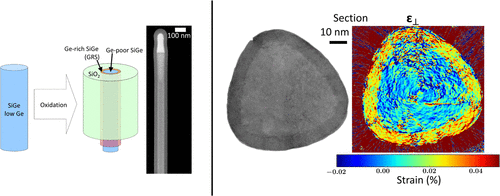当前位置:
X-MOL 学术
›
Nano Lett.
›
论文详情
Our official English website, www.x-mol.net, welcomes your
feedback! (Note: you will need to create a separate account there.)
Tailoring Strain and Morphology of Core–Shell SiGe Nanowires by Low-Temperature Ge Condensation
Nano Letters ( IF 9.6 ) Pub Date : 2017-11-14 00:00:00 , DOI: 10.1021/acs.nanolett.7b02832 Thomas David 1 , Kailang Liu 1 , Antoine Ronda 1 , Luc Favre 1 , Marco Abbarchi 1 , Marc Gailhanou 1 , Pascal Gentile 2 , Denis Buttard 2 , Vincent Calvo 2 , Michele Amato 3 , Jean-Noël Aqua 4 , Isabelle Berbezier 1
Nano Letters ( IF 9.6 ) Pub Date : 2017-11-14 00:00:00 , DOI: 10.1021/acs.nanolett.7b02832 Thomas David 1 , Kailang Liu 1 , Antoine Ronda 1 , Luc Favre 1 , Marco Abbarchi 1 , Marc Gailhanou 1 , Pascal Gentile 2 , Denis Buttard 2 , Vincent Calvo 2 , Michele Amato 3 , Jean-Noël Aqua 4 , Isabelle Berbezier 1
Affiliation

|
Selective oxidation of the silicon element of silicon germanium (SiGe) alloys during thermal oxidation is a very important and technologically relevant mechanism used to fabricate a variety of microelectronic devices. We develop here a simple integrative approach involving vapor–liquid–solid (VLS) growth followed by selective oxidation steps to the construction of core–shell nanowires and higher-level ordered systems with scalable configurations. We examine the selective oxidation/condensation process under nonequilibrium conditions that gives rise to spontaneous formation of core–shell structures by germanium condensation. We contrast this strategy that uses reaction-diffusion-segregation mechanisms to produce coherently strained structures with highly configurable geometry and abrupt interfaces with growth-based processes which lead to low strained systems with nonuniform composition, three-dimensional morphology, and broad core–shell interface. We specially focus on SiGe core–shell nanowires and demonstrate that they can have up to 70% Ge-rich shell and 2% homogeneous strain with core diameter as small as 14 nm. Key elements of the building process associated with this approach are identified with regard to existing theoretical models. Moreover, starting from results of ab initio calculations, we discuss the electronic structure of these novel nanostructures as well as their wide potential for advanced device applications.
中文翻译:

低温Ge凝聚的核壳SiGe纳米线的剪裁应变和形貌。
在热氧化过程中硅锗(SiGe)合金的硅元素的选择性氧化是一种非常重要且与技术相关的机制,可用于制造各种微电子器件。我们在这里开发一种简单的集成方法,包括汽-液-固(VLS)生长,然后是选择性氧化步骤,以构建核-壳纳米线和具有可扩展配置的高级有序系统。我们研究了非平衡条件下的选择性氧化/缩合过程,该过程通过锗缩合自发形成核-壳结构。我们对比了使用反应扩散扩散机制产生具有高度可配置几何结构和突变界面的相干应变结构的策略,该结构具有基于增长的过程,从而导致低应变系统具有不均匀的组成,三维形态和宽泛的核-壳界面。我们特别关注SiGe核-壳纳米线,并证明它们可以具有高达70%的富含Ge的壳和2%的均匀应变,且核直径小至14 nm。根据现有的理论模型,确定了与此方法相关的构建过程的关键要素。此外,从头计算的结果出发,我们讨论了这些新型纳米结构的电子结构以及它们在先进设备应用中的广泛潜力。三维形态和宽广的核-壳界面。我们特别关注SiGe核-壳纳米线,并证明它们可以具有高达70%的富含Ge的壳和2%的均匀应变,且核直径小至14 nm。根据现有的理论模型,确定了与此方法相关的构建过程的关键要素。此外,从头计算的结果出发,我们讨论了这些新型纳米结构的电子结构以及它们在先进设备应用中的广泛潜力。三维形态和宽广的核-壳界面。我们特别关注SiGe核-壳纳米线,并证明它们可以具有高达70%的富含Ge的壳和2%的均匀应变,且核直径小至14 nm。根据现有的理论模型,确定了与此方法相关的构建过程的关键要素。此外,从头计算的结果出发,我们讨论了这些新型纳米结构的电子结构以及它们在先进设备应用中的广泛潜力。根据现有的理论模型,确定了与此方法相关的构建过程的关键要素。此外,从头计算的结果出发,我们讨论了这些新型纳米结构的电子结构以及它们在先进设备应用中的广泛潜力。根据现有的理论模型,确定了与此方法相关的构建过程的关键要素。此外,从头计算的结果出发,我们讨论了这些新型纳米结构的电子结构以及它们在先进设备应用中的广泛潜力。
更新日期:2017-11-15
中文翻译:

低温Ge凝聚的核壳SiGe纳米线的剪裁应变和形貌。
在热氧化过程中硅锗(SiGe)合金的硅元素的选择性氧化是一种非常重要且与技术相关的机制,可用于制造各种微电子器件。我们在这里开发一种简单的集成方法,包括汽-液-固(VLS)生长,然后是选择性氧化步骤,以构建核-壳纳米线和具有可扩展配置的高级有序系统。我们研究了非平衡条件下的选择性氧化/缩合过程,该过程通过锗缩合自发形成核-壳结构。我们对比了使用反应扩散扩散机制产生具有高度可配置几何结构和突变界面的相干应变结构的策略,该结构具有基于增长的过程,从而导致低应变系统具有不均匀的组成,三维形态和宽泛的核-壳界面。我们特别关注SiGe核-壳纳米线,并证明它们可以具有高达70%的富含Ge的壳和2%的均匀应变,且核直径小至14 nm。根据现有的理论模型,确定了与此方法相关的构建过程的关键要素。此外,从头计算的结果出发,我们讨论了这些新型纳米结构的电子结构以及它们在先进设备应用中的广泛潜力。三维形态和宽广的核-壳界面。我们特别关注SiGe核-壳纳米线,并证明它们可以具有高达70%的富含Ge的壳和2%的均匀应变,且核直径小至14 nm。根据现有的理论模型,确定了与此方法相关的构建过程的关键要素。此外,从头计算的结果出发,我们讨论了这些新型纳米结构的电子结构以及它们在先进设备应用中的广泛潜力。三维形态和宽广的核-壳界面。我们特别关注SiGe核-壳纳米线,并证明它们可以具有高达70%的富含Ge的壳和2%的均匀应变,且核直径小至14 nm。根据现有的理论模型,确定了与此方法相关的构建过程的关键要素。此外,从头计算的结果出发,我们讨论了这些新型纳米结构的电子结构以及它们在先进设备应用中的广泛潜力。根据现有的理论模型,确定了与此方法相关的构建过程的关键要素。此外,从头计算的结果出发,我们讨论了这些新型纳米结构的电子结构以及它们在先进设备应用中的广泛潜力。根据现有的理论模型,确定了与此方法相关的构建过程的关键要素。此外,从头计算的结果出发,我们讨论了这些新型纳米结构的电子结构以及它们在先进设备应用中的广泛潜力。











































 京公网安备 11010802027423号
京公网安备 11010802027423号